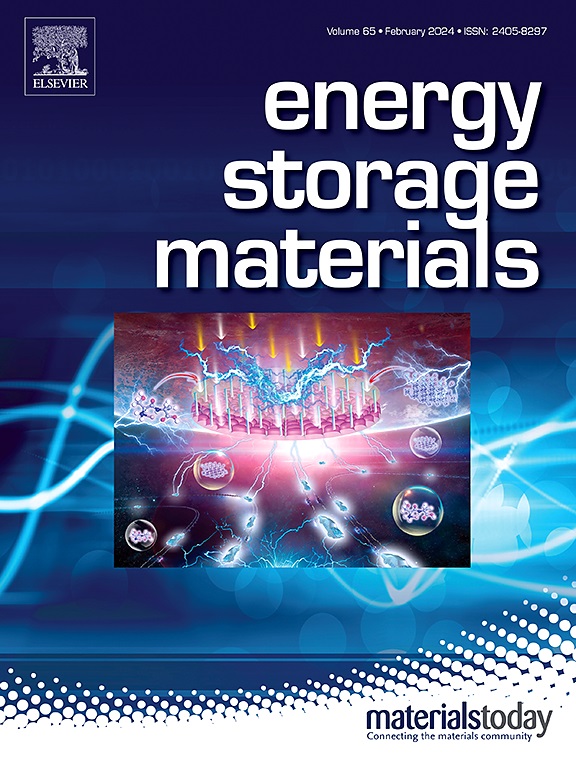A dilute kosmotropic eutectic electrolyte for practical four-electron aqueous Zn−Iodine batteries
IF 20.2
1区 材料科学
Q1 CHEMISTRY, PHYSICAL
引用次数: 0
Abstract
Hydrolysis of I+ and instability of zinc anode in dilute aqueous electrolytes are two main obstacles for constructing high-rate, long-cycle-life and cost-effective aqueous Zn−iodine batteries with I+/I2/I− conversion (4eZIBs). Here, a kosmotropic eutectic electrolyte (KEE) was obtained using ZnSO4·7H2O and 1-Butyl-3-methylimidazolium chloride structure makers. The combined kosmotropic and eutectic features enable highly effective regulation of water activity while simultaneously facilitating reversible and stable chemistries of both the iodine cathode and zinc anode. Specifically, appropriate amount of water is crucial to reversible, fast and stable four-electron transfer of the iodine cathode. Meanwhile, the restricted water activity and water-deficient solvation structure of ZnCl(SO4)(H2O)4− grant stable zinc anodes. Consequently, the 4eZIB with dilute KEE (3.2 M) exhibits stable cycle performance for over 27,000 cycles, along with high Coulombic efficiency of 99.6 %. Moreover, the 4eZIB also demonstrates overall performance enhancement, as manifested in a practical pouch cell. This work provides mechanistic understanding on electrolyte design for solving complex issues in 4eZIBs.
实用四电子锌-碘水电池用稀共晶电解质
稀水电解质中I+的水解和锌阳极的不稳定性是构建高倍率、长循环寿命和高性价比的I+/I2/I−转换(4eZIBs)水锌碘电池的两个主要障碍。本文以ZnSO4·7H2O和1-丁基-3-甲基咪唑氯为原料制备了一种共晶共晶电解质(KEE)。共晶和共晶相结合的特性使水活度的高效调节成为可能,同时促进了碘阴极和锌阳极可逆和稳定的化学反应。具体来说,适量的水对碘阴极可逆、快速、稳定的四电子转移至关重要。同时,ZnCl(SO4)(H2O)4−有限的水活度和缺乏水的溶剂化结构使锌阳极稳定。因此,稀释KEE (3.2 M)的4eZIB循环性能稳定,循环次数超过27,000次,库仑效率高达99.6%。此外,4eZIB还展示了整体性能增强,表现在一个实用的袋式电池。这项工作为解决4ezbs中复杂问题的电解质设计提供了机制理解。
本文章由计算机程序翻译,如有差异,请以英文原文为准。
求助全文
约1分钟内获得全文
求助全文
来源期刊

Energy Storage Materials
Materials Science-General Materials Science
CiteScore
33.00
自引率
5.90%
发文量
652
审稿时长
27 days
期刊介绍:
Energy Storage Materials is a global interdisciplinary journal dedicated to sharing scientific and technological advancements in materials and devices for advanced energy storage and related energy conversion, such as in metal-O2 batteries. The journal features comprehensive research articles, including full papers and short communications, as well as authoritative feature articles and reviews by leading experts in the field.
Energy Storage Materials covers a wide range of topics, including the synthesis, fabrication, structure, properties, performance, and technological applications of energy storage materials. Additionally, the journal explores strategies, policies, and developments in the field of energy storage materials and devices for sustainable energy.
Published papers are selected based on their scientific and technological significance, their ability to provide valuable new knowledge, and their relevance to the international research community.
 求助内容:
求助内容: 应助结果提醒方式:
应助结果提醒方式:


